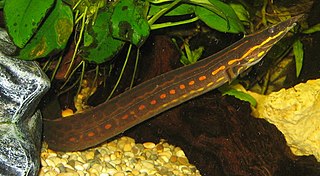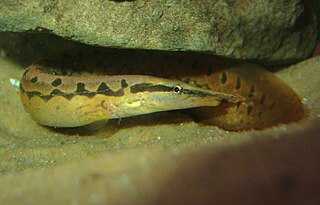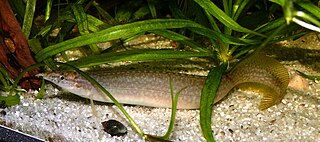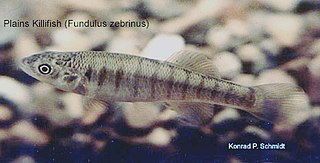
Synbranchiformes, often called swamp eels, is an order of ray-finned fishes that are eel-like but have spiny rays, indicating that they belong to the superorder Acanthopterygii.

The zebra shark is a species of carpet shark and the sole member of the family Stegostomatidae. It is found throughout the tropical Indo-Pacific, frequenting coral reefs and sandy flats to a depth of 62 m (203 ft). Adult zebra sharks are distinctive in appearance, with five longitudinal ridges on a cylindrical body, a low caudal fin comprising nearly half the total length, and usually a pattern of dark spots on a pale background. Young zebra sharks under 50–90 cm (20–35 in) long have a completely different pattern, consisting of light vertical stripes on a brown background, and lack the ridges. This species attains a length of 2.5 m (8.2 ft).

The spiny dogfish, spurdog, mud shark or piked dogfish, is one of the best known species of the Squalidae (dogfish) family of sharks, which is part of the Squaliformes order. While these common names may apply to several species, Squalus acanthias is distinguished by two spines and no anal fin. It lives in shallow waters and further offshore in most parts of the world, especially in temperate waters. Those in the northern Pacific Ocean were reevaluated in 2010 and found to constitute a separate species, now called the Pacific spiny dogfish .
The name spiny eel is used to describe members of two different families of fish: the freshwater Mastacembelidae of Asia and Africa, and the marine Notacanthidae. Both are so-named because of their eel-like shape and sturdy fin spines. These two families are not related: the Notacanthiformes belong to the Superorder Elopomorpha, whose members are characterized by having leptocephalus larvae. The freshwater Mastacembelids do not share this characteristic and are popular specimens in the aquarium trade.

The northern river terrapin is a species of riverine turtle native to Southeast Asia. It is classified Critically Endangered by the IUCN and considered extinct in much of its former range.

Francis Day was an army surgeon and naturalist in the Madras Presidency who later became the Inspector-General of Fisheries in India and Burma. A pioneer ichthyologist, he described more than three hundred fishes in the two-volume work on The Fishes of India. He also wrote the fish volumes of the Fauna of British India series. He was also responsible for the introduction of trout into the Nilgiri hills, for which he received a medal from the French Societe d'Acclimatation. Many of his fish specimens are distributed across museums with only a small fraction deposited in the British Museum, an anomaly caused by a prolonged conflict with Albert Günther, the keeper of zoology there.

The large Indian civet is a viverrid native to South and Southeast Asia. It is listed as Least Concern on the IUCN Red List. The global population is considered decreasing mainly because of trapping-driven declines in heavily hunted and fragmented areas, notably in China, and the heavy trade as wild meat.
Mastacembelus is a genus of many species of spiny eel fish from the family Mastacembelidae. They are native to Africa and Asia. Most are found in rivers and associated systems, but there are also species in other freshwater habitats and a particularly rich radiation is found in the Lake Tanganyika basin with 15 species. A few species can even occur in brackish water.

The fire eel is a relatively large species of spiny eel. This omnivorous freshwater fish is native to in Southeast Asia but also found in the aquarium trade. Although it has declined locally because of this trade and overfishing for food, it remains common overall.
The lesser spiny eel, Macrognathus aculeatus, is a Southeast Asian tropical freshwater fish belonging to the family Mastacembelidae. They are uncommonly found in aquaria.
Macrognathus is a genus of eel-like fish of the family Mastacembelidae of the order Synbranchiformes.

The zig-zag eel, also known as the tire-track eel, tire-track spiny eel or marbled spiny eel, is a species of ray-finned, spiny eels belonging to the genus Mastacembelus of the family Mastacembelidae, and is native to the riverine fauna of India, Bangladesh, Pakistan, Sri Lanka, Thailand, Vietnam, Indonesia and other parts of South East Asia. The species was described as Macrognathus armatus by Lacepède in 1800. Other common names for this popular aquarium species are leopard spiny eel and white-spotted spiny eel. This species is not only a popular aquarium fish but also as a food fish in its country of origin.

Macrognathus siamensis is a tropical fish belonging to the family Mastacembelidae.

Toxotes blythii, the clouded archerfish or zebra archerfish, is a perciform fish of genus Toxotes. It is found in rivers and estuaries in Myanmar, ranging from the lower Irrawaddy to the Tenasserim Division, including lower Sittaung and Salween. Unlike some other archerfish, it is restricted to fresh water. This species was formerly thought to be identical to T. microlepis. However, differences in structure and colouration caused the splitting of T. blythii into a new species. It is sometimes seen in the aquarium trade, but is generally rare.

The brown-cheeked rail or eastern water rail is a species of bird in the family Rallidae. It breeds in northern Mongolia, eastern Siberia, northeast China, Korea and northern Japan, and winters in southeast Asia. It used to be considered a subspecies of the water rail.

Macrognathus pancalus, the barred spiny eel or Indian spiny eel, or পাঁকাল in bengali is a small freshwater fish in southern Asia. It usually is found in slow and shallow rivers. Males are more slender and often smaller than the females.

Fundulus zebrinus is a species of fish in the Fundulidae known by the common name plains killifish. It is native to North America, where it is distributed throughout the Mississippi River, Colorado River, and Rio Grande drainages, and other river systems; many of its occurrences represent introduced populations.
Macrognathus aral, the one-stripe spiny eel, is a small fish from Pakistan, India, Bangladesh, Nepal and Myanmar. It usually is found in running and stagnant waters of freshwater and brackish waters. It is 63.5 cm (25.0 in) in length.
Boulenger's spiny eel is a species of ray-finned fish endemic to India, Myanmar and Thailand, known from Sittaung River, Salween River and Manipur River and possibly Irrawaddy River. Inhabiting large rivers and tributaries, it is consumed by locals but is uncommon in the aquarium trade. It may be threatened by habitat loss for deforestation, dams and overfishing and is harmless to humans.

Macrognathus fasciatus is a species of spiny eel found in the Manimala River and first described in 2014. Macrognathus fasciatus differs from its relative species by the presence of 28–30 dorsal spines, 26–27 vertical lateral lines on the body, 8–9 whitish yellow round spots present in a row in between every two vertical lines and first dorsal spine originate at the level or a little behind the end of pectoral fin.














